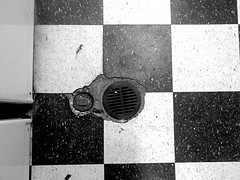The Best Ways to Clear a Clogged Floor Drain
 On the floor of your home's utility areas (like the laundry room, basement, and garage), lives a hardworking, underappreciated piece of plumbing known as a floor drain. Though it tends to be neglected and often doesn't get the regular cleaning it needs, your floor drain does an essential job. It swallows all kinds of sludge and grime like runoff from appliances; dirt, sand, and melted snow from your car; and soap scum, hair, and lint from the washing machine.
On the floor of your home's utility areas (like the laundry room, basement, and garage), lives a hardworking, underappreciated piece of plumbing known as a floor drain. Though it tends to be neglected and often doesn't get the regular cleaning it needs, your floor drain does an essential job. It swallows all kinds of sludge and grime like runoff from appliances; dirt, sand, and melted snow from your car; and soap scum, hair, and lint from the washing machine.
Occasionally an overload causes a drain clog, which can result in water backup and even flooding. This type of plumbing emergency requires immediate attention -- the right kind. Avoid commercial drain cleaners, which are caustic and can eat through your pipes, leaving you with an even bigger problem. Instead, use the alternatives below for the best ways to clear a clogged floor drain.
Plunger
A plunger is a tool that nearly every homeowner has on hand (and if you don't have one, you should!). Smear the edge of the plunger with petroleum jelly to ensure a good seal. Then depress the plunger forcefully several times. Pour in a few cups of water to see whether it drains.
Vinegar and Soda
For this multi-step process, you'll need:
Phillips screwdriver.
Rubber gloves.
Disposable waterproof container to collect gunk.
Old toothbrush.
A 1-lb box of baking soda.
A 32-oz bottle of vinegar.
Boiling water.
1. Use a Phillips screwdriver to remove the screw that holds the drain cover in place. (Stash the screw carefully so it won't get lost.) Put on rubber gloves and lift up the cover. Wipe the underside.
2. Reach into the drain to scoop out gunk with your hands. Dispose of it in the container you have at the ready.
3. Scrub with the toothbrush to get rid of stuck-on dirt or sediment.
4. Pour a quart of boiling water into the drain opening and let it soak for 10 minutes.
5. Sprinkle the drain with the entire contents of the box of baking soda, trying to distribute it evenly.
6. Follow up with a 32-ounce bottle of white vinegar. Combined with the baking soda, it will fizz up and create a powerful cleaning action.
7. Once again, let everything sit for 10 minutes. Then slowly flush with an additional quart of boiling water.
8. Replace the drain cover.
Plumber's Snake (Manual)
If this is not successful, try clearing the drain gently with a manual plumber's snake. Rotate the snake as you insert it. When you feel resistance, you'll know you've reached the source of the blockage. Try to hook the snake onto the clog and keep pushing in order to break it up. Slowly rotate the snake as you withdraw it. Wipe it down with old rags and repeat if necessary. Flush the drain with a stream of water. Once the drain is clear, replace the cover.
Professional Plumbers and High Tech Tools
If none of the above methods is successful, it could be time to hire a professional plumbing service. The average drain cleaning cost is about $200, and it may be well worth it to you to have this headache taken care of.
Qualified plumbers have the experience to quickly and accurately diagnose the cause of the blockage. They then choose the best tools to solve the problem from their stock of high tech equipment -- including fiber optic cameras that allow an interior view of your home's plumbing, powerful electric augers ("Roto-Rooters"), and hydro-jetters, which attack drain clogs effectively with high-pressure streams of water.
But why wait for a plumbing emergency? Savvy homeowners have their drains professionally cleaned every three to five years as a part of their preventive maintenance schedule.
Hire a licensed plumber for reliable plumbing repair and maintenance.
Laura Firszt writes for networx.com.
Updated December 27, 2018.
Looking for a Pro? Call us (866) 441-6648

Plumbing Average Costs
Plumbers Experiences

Sliding Glass Patio Door Replacement Eliminates Rotten Wood

Gas Line Replacement By A Plumber Who Takes Pride In His Work



